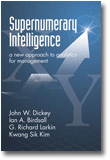
Supernumerary Intelligence
A New Approach to Analytics for Management
By:
John W. Dickey, Virginia Tech
Ian A. Birdsall, Walden University
G. Richard Larkin, Walden University
Kwang Sik Kim, Sungkyunkwan University
Published 2015
Much of our life is consumed looking for quantitative relationships. For example, How much more sleep do I need at night to make me feel better? How many calories do I need to eliminate to lose weight? How much larger does my budget on the job need to be for me to be more effective? All these quantitative questions are preceded, and depend on, qualitative questions. For example, before I decide how much extra sleep I need at night, I need to determine if extra sleep will actually make me feel better. In another example, I need to determine if a larger budget will make me more effective on the job, before I think about how much more money I will need. What elements influence job performance, and how do they interact? We spend much of our life trying to find answers to such quantitative and qualitative questions. We are, then, in search of a kind of intelligence that includes numbers but is also above and beyond them. We call it 'supernumerary' intelligence (SI).
To aid our quest for SI, we use Quantitative CyberQuest (QCQ) and the Public Administration Genome Project (PAGP) as useful tools. QCQ is a philosophy as well as an analytic tool that helps in exploring the supernumerary. QCQ is particularly wellsuited for sorting out variables as well as their interrelations. It involves a combination of statistics, systems analysis, research methodology, qualitative research, and artificial intelligence. QCQ also provides a relatively easy to understand but still powerful set of tools and guidance mechanisms to pilot (the 'Cyber' part) users in their 'Quest' for supernumerary relationships.
CONTENTS
Preface. 1 Introduction. 2 A Different Approach. 3 Case Study: Shopping Center Parking Lot Accumulation. 4 Step 1. Situation Description. 5 Step 2. Theory search. 6 Step 2. Theory Search (Continued). 7 Step 3. Theory Development. 8 Step 3. Theory Development (Continued). 9 Step 3. Theory Development (Continued Again). 10 Step 4. Data Specification and Collection. 11 Step 5. Individual Relationship Development. 12 Step 5. Individual Relationship Development (Continued). 13 Step 6. Relationship Evaluation. 14 Step 7. Forecasting. 15 The Public Administration Genome Project (PAGP). 16 Major Case: Preparing Tomorrow’s Teachers for Technology. 17 Major Case: Reorganization of the Seoul Bus System. 18 U.S. Department of Defense: Joint Total Asset Visibility (JATV) Project. 19 Supernumerary Intelligence in Perspective. A Some Basic Statistics and Mathematics. B Some Additional Case Studies. C Characteristics of Supernumerary Intelligence (by Step in QCQ Process). D Checklist for Cause and Effect Considerations. E Necessary and Sufficient Conditions. F Data. G Warrant-Based Equation Development. References. About the Authors.
-
Paperback9781623968298
Web price: $62.04 (Reg. 72.99)
-
Hardcover9781623968304
Web price: $89.24 (Reg. 104.99)
- eBook9781623968311

- BUS000000 - BUSINESS & ECONOMICS: General
- BUS041000 - BUSINESS & ECONOMICS: Management
- BUS042000 - BUSINESS & ECONOMICS: Management Science
-
 Dark and Destructive Leadership
Dark and Destructive Leadership
-
 Digital Transformation
Organizational Challenges and Management Transformation Methods
Digital Transformation
Organizational Challenges and Management Transformation Methods
-
 Diversity, Equity, and Inclusion Insights in Practice
Diversity, Equity, and Inclusion Insights in Practice
-
 Management Consulting in the Era of the Digital Organization
Management Consulting in the Era of the Digital Organization
-
 Perspectives on Race in Organizations
Perspectives on Race in Organizations
-
 The Entrepreneurship SIG at the European Academy of Management
Setting the Base for Tomorrow's Challenges
The Entrepreneurship SIG at the European Academy of Management
Setting the Base for Tomorrow's Challenges
-
 The Plight of Stigmatized Groups in Organizations
The Plight of Stigmatized Groups in Organizations

